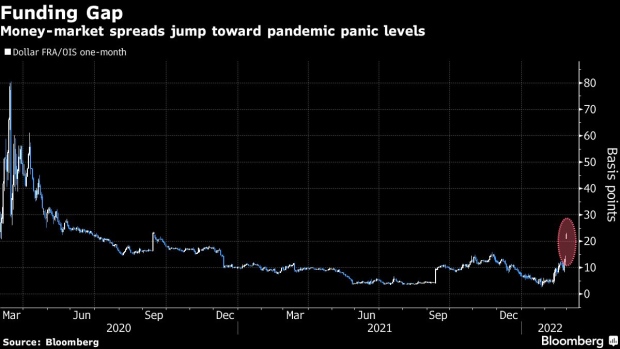Feb 28, 2022
Money Markets Stressed as Russia Sanctions Fuel Uncertainty
, Bloomberg News

(Bloomberg) --
Signs of stress are appearing in money markets as traders struggle to gauge the impact of toughened Western sanctions against Russia on liquidity.
The gap between future Libor and Fed rates -- the FRA/OIS spread -- widened 10 basis points for one-month contracts, the most since March 2020. Other key money-market indicators fluctuated, including three-month dollar-yen basis swaps, while March eurodollar contracts underperformed June peers.
The moves may reflect traders’ concern that dollar funding costs could increase as tensions in Ukraine escalate. The decision to exclude various Russian lenders from the SWIFT messaging system could result in missed payments, and prompt monetary authorities to supply the market with dollars, according to Credit Suisse Group AG strategist Zoltan Pozsar.
“Details on sanctions were fairly vague so the market will be looking for more clarity, but there is no doubt the goal of the sanctions is to drive a liquidity crisis within the Russian economy,” said Prashant Newnaha, an Asia-Pacific rates strategist at TD Securities. “The moves in front-end basis aren’t too surprising, a classic risk-off move, while spreads are wide and liquidity thin.”
The dislocations added to concerns that the impact of the Ukraine crisis is piling stress on fixed-income markets which were already showing signs of dysfunction as the Federal Reserve and its peers accelerated plans to tighten policy.
The three-month dollar-yen basis swap -- which helps govern costs for traders to swap interest rates across currencies -- fell as much as 29 basis points to minus 64 basis points as demand for dollars surged. This indicates dollar funding costs have jumped for yen-based investors to levels last seen in March 2020.
SWIFT Ban on Russia Means the Fed May Need to Ready Dollars (1)
Russia had about $300 billion of foreign currency held offshore -- enough to disrupt money markets if it’s frozen by sanctions or moved suddenly to avoid them -- Credit Suisse Group estimated last week.
Newnaha said a key question is whether funding stresses extend during the European day when there is usually more liquidity.
©2022 Bloomberg L.P.